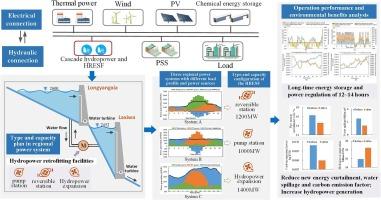区域混合能源系统中水电改造储能设施的类型及容量配置
IF 10.9
1区 工程技术
Q1 ENERGY & FUELS
引用次数: 0
摘要
随着大规模新能源向电网的渗透,为保证电网安全稳定运行,对多时间尺度储能和灵活调控的要求越来越高。在现有梯级水库基础上建设的水电改造储能设施,通过实现梯级水电的循环利用,提供了长时间的储能和灵活的调节。本研究提出了一个框架,通过电力系统扩展模型来确定水电改造储能设施的必要性、类型和容量,以最大限度地降低整个生命周期的安装和运行成本。为支持扩建方案的技术经济评价,建立了多时间尺度调度模型和时间序列仿真方法。以黄河上游龙阳峡-拉西瓦梯级水库为例,对三个不同需求特征的区域电网进行了分析。结果表明,水电改造储能设施的类型和容量选择取决于系统需求和运行经济性。可以将多余的新能源电力转化为潜在的水电,利用季节性溢水发电,减少火电调峰运行。水电改造储能设施可使新能源利用率提高0.1 - 2.18%,减少碳排放0.84 - 167万吨。在极端新能源发电条件下,可提供每天12-14小时的连续储能和调节能力。在单位容量投资、燃料和碳排放成本变化±20%的情况下,所选择的类型和容量配置保持不变。本文章由计算机程序翻译,如有差异,请以英文原文为准。

Type and capacity configuration of hydropower retrofitted energy storage facilities in the regional hybrid energy system
With the increasing penetration of large-scale new energy into power grids, multi-time-scale energy storage and flexible regulation are increasingly required to ensure safe and stable operation. Hydropower retrofitted energy storage facilities, built on existing cascade reservoirs, offer extended-duration energy storage and flexible regulation by enabling cascade hydropower recycling. This study proposes a framework for determining the necessity, type, and capacity of the hydropower retrofitted energy storage facilities through a power system extension model aimed at minimizing lifecycle installation and operation costs. A multi-time-scale scheduling model and time-series simulation method are developed to support the technical–economic evaluation of expansion schemes. A case study on the Longyangxia-Laxiwa cascade reservoirs located on the upper Yellow River, China, is conducted for three regional power grids with varying demand characteristics. Results indicate that the type and capacity selection of the hydropower retrofitted energy storage facilities depend on system demand and operational economy. They can transformed excess new energy power into potential hydropower, utilized the seasonal spilled water for power generation and reduced the peak-shaving operation of thermal power. The hydropower retrofitted energy storage facilities are shown to increase new energy utilization by 0.1–2.18 % and reduce carbon emissions by 0.84–1.67 million tons. Continuous energy storage and regulation capacity of 12–14 h per day can be provided under extreme new energy generation conditions. The selected type and capacity configuration remain unchanged under a ±20 % variation in unit capacity investment, fuel and carbon emission cost.
求助全文
通过发布文献求助,成功后即可免费获取论文全文。
去求助
来源期刊

Energy Conversion and Management
工程技术-力学
CiteScore
19.00
自引率
11.50%
发文量
1304
审稿时长
17 days
期刊介绍:
The journal Energy Conversion and Management provides a forum for publishing original contributions and comprehensive technical review articles of interdisciplinary and original research on all important energy topics.
The topics considered include energy generation, utilization, conversion, storage, transmission, conservation, management and sustainability. These topics typically involve various types of energy such as mechanical, thermal, nuclear, chemical, electromagnetic, magnetic and electric. These energy types cover all known energy resources, including renewable resources (e.g., solar, bio, hydro, wind, geothermal and ocean energy), fossil fuels and nuclear resources.
 求助内容:
求助内容: 应助结果提醒方式:
应助结果提醒方式:


